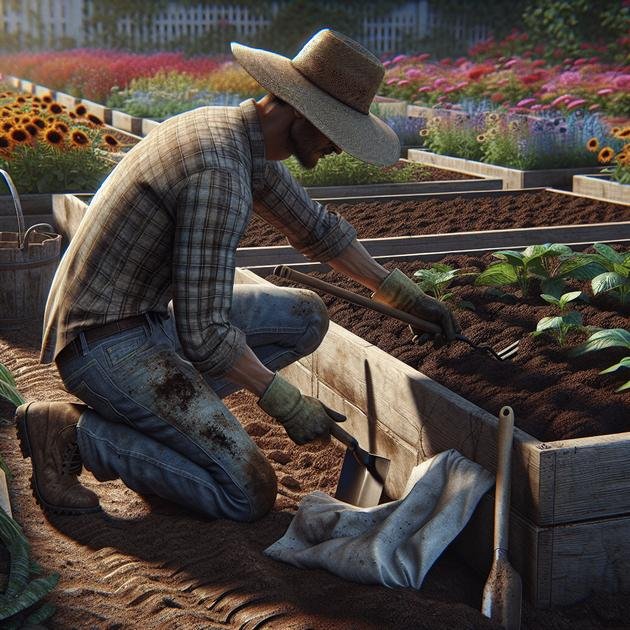Winter garden prep involves assessing garden health, clearing debris, protecting soil with mulch, pruning, winterizing tools, setting up cold frames, choosing crops wisely, planning crop rotation, preparing compost, watering smartly, managing pests, insulating plants, applying organic fertilizers, organizing seeds, and scheduling spring planting to ensure a successful growing season.
Ever wondered how to get your green space ready for the harsh winter months? Winter garden prep isn’t just about survival; it’s about setting up a spring full of life and beauty. Let’s explore some down-to-earth ways to make your garden thrive when warmer days arrive.
assessing your garden’s health before winter
Before winter sets in, it’s crucial to assess your garden’s health to identify any problems that could affect its recovery in spring. Begin by inspecting plants for signs of disease, pests, or damage. Look for discoloration, wilting, or unusual spots on leaves and stems.
Check the soil moisture and texture, as well as drainage conditions. Compacted or overly dry soil can stress plants during the cold months. Take note of any affected areas that may need extra attention or treatment.
Evaluate the overall structure of your garden beds and borders. Remove any dead or dying plants to prevent disease spread. Make a list of plants that may need protection or pruning before the first frost.
Taking the time to assess your garden now helps you create an effective plan to nurture it through winter and prepare for a successful spring bloom.
clearing debris and fallen leaves
Clearing debris and fallen leaves from your garden is essential to prevent mold, pests, and diseases during winter. Accumulated leaves can trap moisture, creating a perfect environment for fungi and insects to thrive. Rake up leaves regularly and remove old plant debris such as dead stems, weeds, and spent flowers.
Composting these materials is a great way to recycle nutrients back into your garden. However, ensure that diseased plants and invasive weeds are disposed of properly and not added to your compost pile.
Clearing debris also helps improve air circulation and sunlight penetration, which benefits the overall health of your plants. Use garden gloves and tools designed for the job to make this task easier and safer.
By keeping your garden clean, you reduce the risks of winter damage and prepare the soil for healthy growth in spring.
protecting soil with mulch
Protecting soil with mulch is a vital step in winter garden prep. Mulch acts as a natural barrier that helps retain soil moisture, regulate temperature, and prevent erosion. Applying a thick layer of organic mulch such as shredded bark, straw, or leaves helps insulate plant roots against freezing temperatures.
Mulching also suppresses weed growth by blocking sunlight, which reduces competition for nutrients and water. Spread mulch evenly around your garden beds, avoiding direct contact with plant stems to prevent rot.
In addition to protecting soil, mulch gradually breaks down and adds valuable nutrients back into the earth, enhancing soil structure and fertility for spring planting. Replenish mulch layers as needed to maintain consistent coverage during winter months.
Choosing the right type of mulch and applying it properly supports a healthy garden ecosystem and sets the stage for strong spring growth.
pruning trees and shrubs for winter

Pruning trees and shrubs before winter is essential to promote healthy growth and prevent damage from heavy snow or ice. Focus on removing dead, damaged, or diseased branches to reduce the risk of breakage during cold weather. Use clean, sharp tools to make precise cuts just above a bud or branch junction.
Thin out dense areas to improve air circulation and reduce the chance of fungal infections. Avoid heavy pruning late in the season, as it may stimulate new growth that won’t have time to harden off before frost.
For shrubs, shape them to maintain size and form while removing any crossing or rubbing branches. Remember to clean up all cuttings and debris to reduce pest habitats.
Pruning correctly helps trees and shrubs conserve energy through winter and prepares them for vigorous growth in spring.
winterizing garden tools
Winterizing garden tools protects your investment and ensures they’re ready for use in spring. Start by cleaning tools thoroughly to remove dirt, sap, and plant residue. Use a wire brush or steel wool for stubborn grime, and dry them completely to prevent rust.
Sharpen blades on pruners, shears, and shovels to maintain their effectiveness. Apply a thin layer of oil, such as machine oil or WD-40, on metal parts to create a protective barrier against moisture.
Inspect tools for damage like loose handles or cracked grips, repairing or replacing parts as needed. Store all tools in a dry, sheltered area, ideally hanging or off the ground to avoid moisture accumulation.
Label and organize your tools so you can find them easily when gardening season returns. Proper winter care can extend the life of your garden tools and improve your gardening efficiency.
setting up cold frames and cloches
Setting up cold frames and cloches is an effective way to extend your gardening season and protect plants from frost during winter. Cold frames are low, box-like structures with transparent tops that trap sunlight and warm the soil. Cloches are small, dome-shaped covers that shield individual plants from cold temperatures and wind.
Choose a sunny location for your cold frame or cloche to maximize heat absorption. Ensure proper ventilation by opening frames or lifting cloche lids on warmer days to prevent overheating and moisture buildup.
Cold frames can be constructed from wood or recycled materials with glass or clear plastic tops, while cloches are often made from plastic, glass, or even cut plastic bottles.
Using these protective tools helps seedlings and tender plants survive cold spells, allowing for earlier planting in spring and extending growth for hardy varieties through fall and winter.
choosing winter crops wisely
Choosing winter crops wisely is essential to ensure a productive garden during colder months. Opt for hardy vegetables and greens that can tolerate frost and lower temperatures, such as kale, spinach, Brussels sprouts, and winter cabbage. These plants thrive in cool weather and often improve in flavor after a frost.
Plan your crop selection based on your local climate and the length of your growing season. Consider using cold frames or cloches to extend the growing period for less hardy crops like lettuce or radishes.
Rotate crops to maintain soil health and reduce pest risks. Winter legumes, such as peas, can enrich the soil by fixing nitrogen, providing benefits for spring planting.
By selecting the right winter crops, you maximize garden productivity while preparing the soil for a strong, healthy spring season.
planning crop rotation for spring

Planning crop rotation for spring is a smart strategy to maintain soil health and improve garden productivity. Rotate crops by planting different plant families in each bed every season to reduce soil-borne diseases and pest buildup. For example, follow nitrogen-fixing legumes with heavy feeders like tomatoes or corn.
Divide your garden into sections and assign each section a different crop group each year. This rotation helps balance nutrient use and replenishment, preventing soil depletion.
Incorporate cover crops such as clover or rye during the off-season to protect the soil from erosion, suppress weeds, and naturally add nitrogen. Plan your spring planting based on this rotation to promote strong, healthy plants.
Consistent crop rotation supports a sustainable garden and reduces the need for chemical fertilizers and pesticides.
preparing compost for nutrient boost
Preparing compost for a nutrient boost is an excellent way to enrich your garden soil naturally. Start by gathering a balanced mix of green materials like kitchen scraps, grass clippings, and fresh leaves, along with brown materials such as dried leaves, straw, and cardboard. This balance provides essential nitrogen and carbon for effective decomposition.
Create a compost pile in a well-drained, shaded spot in your yard. Turn the pile regularly to increase airflow and speed up the breakdown process. Keep the compost moist but not soggy, similar to a damp sponge.
Adding garden waste and small amounts of soil or finished compost can introduce beneficial microorganisms that aid decomposition. Over time, this mixture will transform into rich, dark compost that improves soil structure, moisture retention, and nutrient content.
Use finished compost in your garden beds in late winter or early spring to give plants a healthy start for the growing season.
watering smart during cold months
Watering smart during cold months is crucial because plants need less water but still require moisture to survive. Overwatering can lead to root rot and other problems, especially in colder weather when evaporation rates are low.
Check soil moisture regularly before watering. If the soil still feels damp a few inches below the surface, hold off on watering. Use a watering can or drip irrigation to provide water slowly and evenly, avoiding excess runoff.
Water your garden during the warmest parts of the day to help the moisture soak in and reduce the risk of freezing. Focus on the base of plants rather than leaves to minimize evaporation and fungal diseases.
Remember that established plants generally need less water in winter. Adjust your watering schedule based on weather conditions, soil type, and plant needs to keep your garden healthy without wasting water.
keeping pests at bay in winter
Keeping pests at bay in winter is important to protect your garden and ensure a healthy start in spring. Many pests seek shelter in garden debris or plant material during cold months, so maintaining a clean garden is your first line of defense.
Remove fallen leaves, dead plants, and other debris where pests can hide. Regularly inspect plants for eggs, larvae, or signs of damage. Use natural pest control methods like introducing beneficial insects and applying neem oil or insecticidal soap if necessary.
Consider using row covers or fine netting to prevent pests from reaching young or vulnerable plants. Keep garden tools and equipment clean to avoid spreading pests and diseases.
Proper winter garden prep reduces pest populations, helping your garden start strong when warmer weather returns.
insulating roots and sensitive plants

Insulating roots and sensitive plants is key to protecting them from freezing temperatures during winter. Use materials like straw, shredded leaves, or mulch to surround the base of plants and cover the root zone. This layer acts as a natural blanket, retaining soil warmth and moisture.
For extra protection, wrap sensitive shrubs or small trees with burlap or horticultural fleece, which helps shield them from harsh winds and frost. Avoid piling insulating materials directly against plant stems to prevent rot.
Container plants are especially vulnerable; consider moving them to sheltered spots or wrapping pots with insulating materials like bubble wrap.
Regularly check insulation throughout winter to ensure it stays intact and adjust as needed. Proper insulation helps plants survive and thrive once spring arrives.
using organic fertilizers before frost
Using organic fertilizers before frost helps strengthen plants and improve soil quality going into winter. Organic fertilizers release nutrients slowly and improve soil structure, making them ideal for autumn application.
Apply compost, well-rotted manure, or seaweed extract to garden beds to boost nutrient levels. These natural options provide essential elements like nitrogen, phosphorus, and potassium that support root development and plant resilience.
Spread fertilizers evenly and water them in to help nutrients penetrate the soil. Avoid over-fertilizing, as excessive nitrogen right before frost can encourage tender growth that is vulnerable to damage.
This preparation nourishes plants through winter and sets a healthy foundation for vigorous spring growth.
organizing your seed inventory
Organizing your seed inventory before winter helps you stay prepared for spring planting. Start by sorting seeds by type and labeling them clearly with names, planting dates, and any specific growing notes. Use airtight containers or sealed bags to keep seeds dry and protected from pests.
Store seeds in a cool, dark place with consistent temperature to maintain viability. A refrigerator or dedicated seed storage box works well for this purpose.
Check the expiration dates and perform germination tests on older seeds to assess their viability. Discard any seeds that no longer sprout effectively.
Keeping a detailed seed inventory saves time and reduces waste, ensuring you have the right seeds available for a successful spring garden.
planning a spring planting schedule
Planning a spring planting schedule helps you organize your garden activities and maximize growth. Start by listing the vegetables, flowers, or herbs you want to grow. Identify their ideal planting times based on your local climate and last frost date.
Create a calendar to map out sowing, transplanting, and harvesting dates. Group plants with similar needs to streamline your care routine. Consider starting seeds indoors for early crops like tomatoes and peppers.
Factor in crop rotation and companion planting to boost soil health and reduce pests. Keep notes on each planting cycle to improve your schedule year after year.
A well-planned schedule ensures you don’t miss critical planting windows and helps maintain a steady harvest throughout the season.
Wrapping Up Winter Garden Prep
Taking the time to prepare your garden for winter sets the foundation for a successful spring. By assessing your garden, clearing debris, protecting soil, and planning your planting schedule, you give your plants the best chance to thrive.
Simple steps like insulating roots, choosing the right crops, and keeping pests away make a big difference. Remember, smart garden care during winter saves time and effort later on.
Start your winter garden prep today and look forward to a healthy, vibrant garden when spring arrives.





